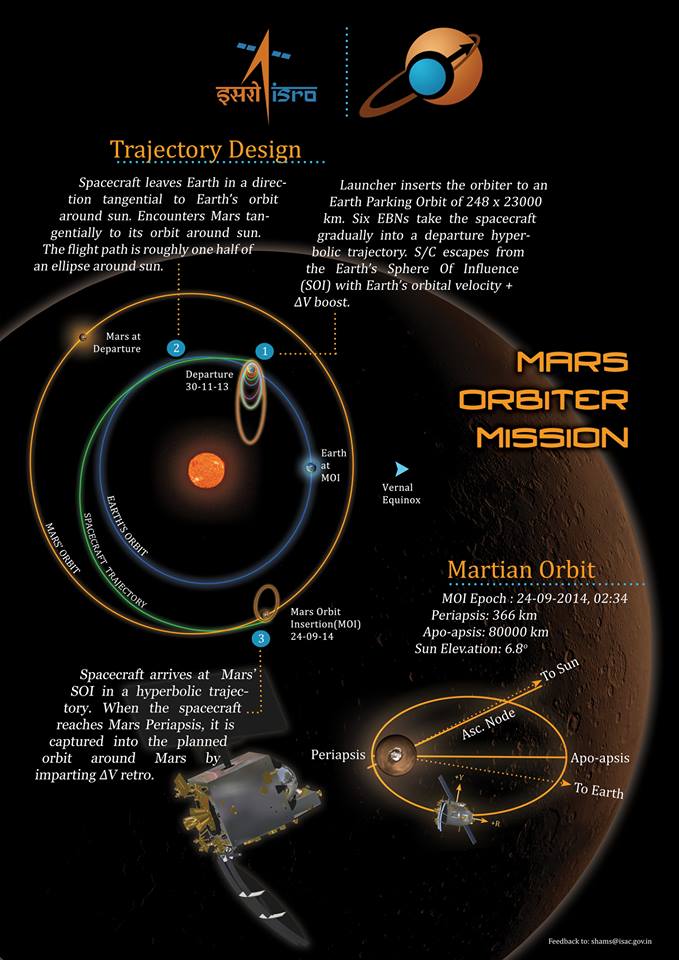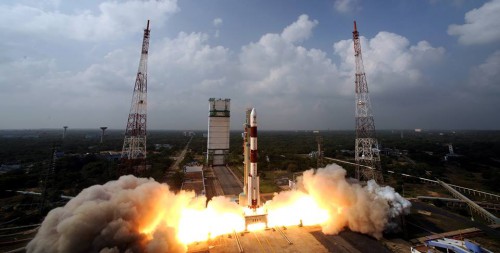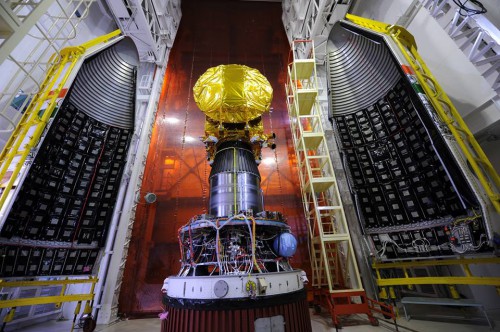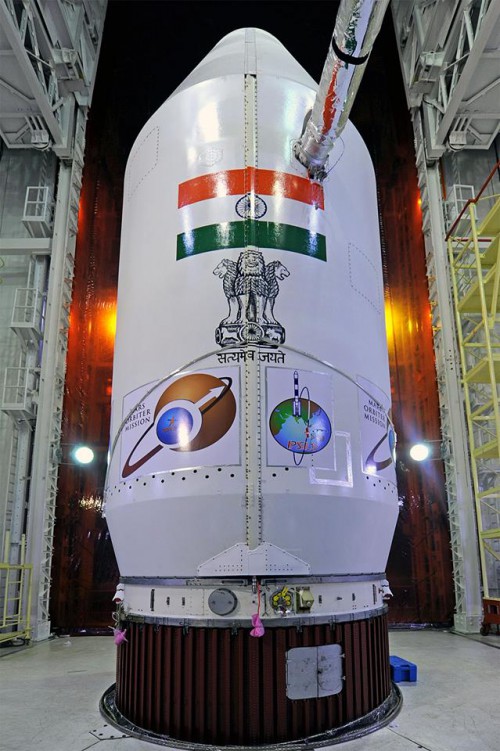
India’s goal of becoming only the fourth discrete nation or group of nations—after the United States, Russia, and the member states of the European Space Agency (ESA)—to successfully despatch its own, homegrown spacecraft to Mars orbit took another step forward yesterday (Monday, 16 June). Its Mars Orbiter Mission (MOM), also known as “Mangalyaan” (Hindi for “Mars Craft”), is now less than 100 days from its scheduled 24 September entry into orbit around the Red Planet. “MOM is rapidly racing towards its target and almost 70 percent of the journey is complete,” the Indian Space Research Organisation (ISRO) declared on its Facebook page, noting that the spacecraft has presently traveled 290 million miles (466 million km) of an anticipated 420-million-mile (680-million-km) mission and its radio signal presently requires a full six minutes to reach us.
Launched atop India’s Polar Satellite Launch Vehicle (PSLV) from the Satish Dhawan Space Centre, on the barrier island of Sriharikoa, last 5 November, MOM/Mangalyaan’s ability to reach Mars was restricted by the relatively limited propulsive yield of both the rocket and the spacecraft’s own Liquid Apogee Motor (LAM). These factors made it infeasible to inject MOM/Mangalyaan directly onto a trans-Mars trajectory. Instead, it was inserted very precisely into a highly elliptical Earth orbit of about 155 x 14,600 miles (250 x 23,500 km) by the PSLV. The spacecraft was then tasked with executing a series of six LAM “burns,” over a period of about three weeks, to steady expand its apogee to a maximum of 119,846 miles (192,874 km) from Earth, whereupon it would escape the Home Planet’s sphere of gravitational influence and establish itself onto a hyperbolic trajectory for arrival at Mars about 10 months later.
Following its launch, MOM/Mangalyaan was placed into an orbit which very closely paralleled pre-flight predictions, inclined 19.27 degrees to the equator and with a period of slightly less than seven hours. After separation from the final stage of the PSLV, its main antenna and electricity-generating solar arrays were deployed, and the first orbit-raising burn of the LAM occurred on 7 November. It lasted 416 seconds and lifted MOM/Mangalyaan’s apogee to 17,550 miles (28,852 km). Subsequent burns further expanded the spacecraft’s apogee, firstly to 24,970 miles (40,186 km) on 8 November, then to 44,500 miles (71,636 km) on 9 November and later—after minor technical difficulties—to 73,720 miles (118,642 km) by 12 November. The next LAM firing on 16 November pushed MOM/Mangalyaan to 119,846 miles (192,874 km) and the final boost on 1 December enabled it to depart Earth’s gravitational influence and set sail for Mars. Tracking was provided by the Spacecraft Control Centre at ISRO Telemetry, Tracking and Command Network (ISTRAC) in Peenya, Bangalore, supported by the Indian Deep Space Network (IDSN) at Byalalu.

“The spacecraft leaves Earth in a direction tangential to Earth’s orbit,” explained ISRO’s official brochure for the MOM/Mangalyaan mission, “and encounters Mars tangentially to its orbit,” noting that these “minimum-energy” opportunities to reach the Red Planet under conditions of the best economy of propellant expenditure, mission duration, and trajectory design arise approximately every 780 days. In addition to the LAM burns, several health checks of the spacecraft and payloads have been performed, with ISRO confirming that all systems continue to operate normally. The first Trajectory Correction Maneuver (TCM-1) of the LAM was executed on 11 December, by which time the spacecraft was 1.8 million miles (2.9 million km) from Earth, and by April 2014 it had crossed the halfway mark in its journey. Last Wednesday (11 June), it performed a second successful TCM and ISRO told its Facebook followers that “Team MOM is busy crunching numbers to determine the post-TCM-2 trajectory.”
The 2,980-pound (1,350-kg) MOM/Mangalyaan spacecraft is equipped with five discrete scientific instruments—the Methane Sensor for Mars (MSM), Mars Colour Camera (MCC), Mars Exospheric Neutral Composition Analyser (MENCA), Thermal Infrared Spectrometer (TIR), and Lyman-Alpha Photometer (LAP)—and will demonstrate the technology needed to deliver a spacecraft to the Red Planet and conduct meaningful science. Upon arrival in September 2014, it will spend at least six months orbiting Mars, focusing on the morphology, topography, and mineralogy of the surface, together with the dynamics of its thin upper atmosphere, its loss of water, the influence of solar wind and radiation, and the nature of its moons, Phobos and Deimos.
“The spacecraft arrives at the Mars Sphere of Influence in a hyperbolic trajectory,” continued ISRO. “At the time the spacecraft reaches the Closest Approach to Mars (periapsis), it is captured into planned orbit around Mars by impacting delta-V retro, which is called the Mars Orbit Insertion (MOI) manoeuvre.” According to current mission plans, MOI will occur at 2:34 a.m. IST on 24 September 2014, and MOM/Mangalyaan will enter an orbit of 310 x 50,000 miles (500 x 80,000 km), inclined 150 degrees. In this highly elliptical orbit, it will circle the planet once every 76.72 hours. Quoting ISRO officials, FirstPost India noted last year that the minimum life of MOM/Mangalyaan in Mars orbit is six months, but hopes are high that it will exceed this target.

India’s 100-day “Countdown to Mars” achievement comes only days after NASA’s Mars Atmosphere and Volatile Evolution (MAVEN) mission, launched last 18 November, passed the same milestone on Friday, 13 June. Unlike MOM/Mangalyaan, the MAVEN spacecraft was inserted directly onto a trans-Mars trajectory—thanks to United Launch Alliance’s (ULA) mighty Atlas V booster—and will reach the Red Planet a few days sooner, despite having been launched a few days later, than its Indian counterpart.
This mission is both highly ambitious and highly unlikely for the world’s second most populous nation, and its merits and motivations have triggered considerable debate. It is described as “a technology demonstration project,” and its primary task is to prove that India can design, plan, manage, launch, and operate a deep-space mission across the enormous gulf to reach the Red Planet. It only received formal approval and a $41 million financial injection from the Indian government in August 2012. With anticipated costs as high as $100 million, the mission has unsurprisingly provoked debate from critics who feel that India could better spend the money on more down-to-earth issues, such as power failures, droughts, and the aftermath of Cyclone Phailin. Still, one government official retorted in a BBC interview that “India is today too big to be just living on the fringes of high technology.”
Hopes are high for MOM/Mangalyaan, as India sets out on a path to become the fourth discrete organization, nation, or group of nations to successfully send its own mission to Mars. Only Russia, the United States, and the member states of the European Space Agency (ESA) have accomplished this feat to date. Yet the stakes are even higher, particularly in the wake of the ignominious fate of Russia’s Fobos-Grunt and China’s Yinghuo-1 spacecraft, which failed to leave Earth orbit in November 2011 and burned up in the atmosphere a few weeks later. “For Mars, there were 51 missions so far the world around,” ISRO Chairman Dr. K. Radhakrishnan told India’s Economic Times last year, “and there were 21 successful missions. It’s a complex mission.” He pointed out that the difference between success and failure in any space enterprise “is very, very thin,” but stressed that even a failure provides a stepping stone to success. Coming less than two years after the Fobos-Grunt and Yinghuo-1 failure, Dr. Radhakrishnan denied overt competition with China and scoffed at the notion of a “race” to Mars between the two nations. “We are in competition with ourselves,” he said, “in the areas that we have charted for ourselves. Each country has its own priorities.”
Dr. Radhakrishnan has admitted that the MOM/Mangalyaan mission will be a challenge, an opportunity and a matter of national pride, as well as illustrating the growing maturity of India’s space program. “Such scientific missions post very tough challenges to technologists,” he said. “Some of the outcomes—for example, the in-built autonomy we are providing in this spacecraft—can become a reality as a product or system and be used in satellites to improve their efficiency. So they percolate to application, which is our main objective. It could be something like forecasting cyclones. There is always relevance for a mission such as this.”

The spacecraft’s in-built autonomy has been incorporated in response to a recognition that the maximum Earth-Mars Round Trip Light Time (RLT) will be 42 minutes, making it “impractical to micromanage the mission from Earth with ground intervention.” As a consequence, MOM/Mangalyaan adopts autonomous Fault Detection, Isolation, and Reconfiguration (FDIR) logic, none of whose actions will disrupt the spacecraft’s Earth Pointing Attitude. ISRO considers this system to be essential during any communications problems or interruptions—during eclipses, for example—and it will safeguard the spacecraft during its insertion into Martian orbit.
Conditions in interplanetary space and in orbit around the Red Planet have also been simulated during numerous ground tests. The performance characteristics of the critical Liquid Apogee Motor have been evaluated in ISRO’s High Altitude Test Facility, whilst thermal balance tests have yielded baseline data for Mars radiation flux and have helped to validate thermal models. In order to handle the frigid cold of a Martian eclipse, MOM/Mangalyaan solar array “coupons” have been subjected to temperature conditions as low as -200 degrees Celsius, qualifying both the cells and their bonding agents. The spacecraft’s communications system has been exhaustively tested and verified by both ISRO and NASA’s Jet Propulsion Laboratory (JPL) of Pasadena, Calif., whose Deep Space Network (DSN) will work alongside the Indian Deep Space Network (IDSN) in tracking MOM/Mangalyaan. These tests have demonstrated “communications management” at the predicted distance between Earth and Mars at the point of MOI, an estimated 133 million miles (214 million km), and after six months in orbit, an estimated 233 million miles (375 million km).
Want to keep up-to-date with all things space? Be sure to “Like” AmericaSpace on Facebook and follow us on Twitter: @AmericaSpace
Missions » MOM »



Is this a very creative low cost program that could be adopted by others to use far less fuel to reach mars and land a craft on the surface?